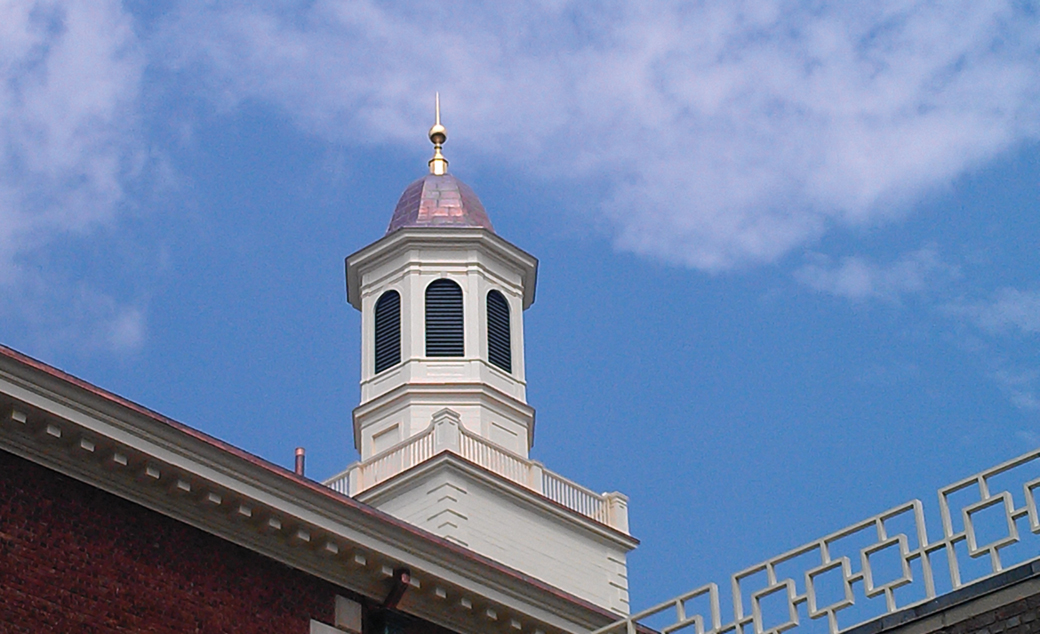Environmentally responsible building methods such as vegetative roof systems and LEED®-certified construction practices continue to increase in popularity as sustainable buildings and designs prove to be environmentally and financially beneficial. Municipalities throughout the U.S. are following the example of cities such as Chicago, which currently leads the nation in vegetative roof systems. Local governments are offering tax incentives for homes and businesses to go green and, in some cases, mandating certain building practices for new construction.
Made more accessible by advances in water, horticulture and engineering sciences, vegetative roof systems' popularity in the U.S. is increasing after many successful years in Europe, primarily in Germany. Vegetative roof systems offer many long-term benefits when installed correctly.
The basics
The NRCA Vegetative Roof Systems Manual, Second Edition defines a vegetative roof system as "a roof area of plantings/landscaping installed above a waterproofed substrate at any building level that is separated from the ground beneath it by a man-made structure. A vegetative roof system consists of a waterproofing system and its associated components—such as protection course, root barrier, drainage layer, thermal insulation and aeration layer—and an overburden of growth medium and plantings."
There are many building construction components to consider, and the reasons for installing vegetative roof systems on a property vary, as well. No matter the impetus, vegetative roof system construction has the same basic blueprint: deck, waterproofing, insulation, drainage, growth medium and, of course, plants.
As with all roof system projects, a vegetative roof system's success relies greatly on proper design, quality materials and quality work. These three things done skillfully, along with proper and consistent maintenance, will ensure a vegetative roof system that will perform satisfactorily for its anticipated service life of 35 years or more, which is about twice the average life span of a traditional roof membrane system.
The composition
Vegetative roof system installation practices vary greatly in the U.S. because of the diverse climates that exist. And planting choices are dictated by local weather, as well as the maximum depth of the growth medium allowed. A structure's roof deck also must be assessed to understand its weight-bearing capacity. These key components must be considered before a vegetative roof system is installed.
The main challenge when designing and installing a vegetative roof system is to mimic a natural, open vegetative space while keeping it lightweight, affordable and as low maintenance as possible. New generations of vegetative roof systems rely on a combination of horticulture, waterproofing and roof engineering.
Drainage
Drainage design should support optimal growth conditions and manage heavy rainfall without sustaining damage from erosion or ponded water. Vegetative roof system designers should design a primary roof drainage system that can remove rainwater at a rate equal to or greater than that resulting from a 60-minute rainfall (based on the 100-year mean recurrence interval [MRI]). A second, backup drainage system independent of the primary drainage system will be required by building code if the roof perimeter construction extends above the roof in such a manner that water will be entrapped if the primary drains are blocked.
Other helpful tips include:
- Ensuring the base (invert) of the secondary drainage inlets are elevated at least 2 inches but no more than 6 inches above the base of the primary drainage inlets
- Adding the weight of rainwater (based on the depth required to achieve the secondary drainage design capacity) in the roof system design load and considering potential ponding resulting from roof system deflections
- Using drains and outlets with inspection chambers that have removable covers to allow for inspection and to block dirt and other debris from entering the drains
Plant choice
Careful design will promote plant growth, provide protection from wind and offer good water retention. There are a few characteristics that make for good vegetative roof plants, but the most important are fire resistance, drought resistance and a noninvasive vertical root system.
Low-maintenance plants that are appropriate for the local climate and a rooftop microclimate should be used. Stay away from grasses and mosses, which can dry out and create a fire hazard. It is best to use at least 60 percent of plantings from the sedum family for ground cover, and it is a best practice to incorporate at least three species of sedum in equal quantities.
Plant selection will depend on a roof system's primary purpose but often comes down to how much time and money a building owner has to invest in maintenance. The plants selected for a vegetative roof should be compatible with the construction location and planting zone as well as resistance to weather, insects and disease. Ideal plants are hardy, fast-growing, noninvasive and fire-resistant. For minimal maintenance, they should have a shallow, fibrous root system and resist damage from foot traffic. Succulent ground covers such as delosperma, jovibarba and sedum are top choices.
If you plan to propagate from cuttings or dry seed, use noncombustible photo-degradable mesh wind blankets to keep erosion at bay until the plants are big enough to perform that task. This might take two to three growing seasons. It's best to choose plants that will grow no taller than 3 feet, considering weight load on the roof and potential wind damage.
In terms of soil, it is best to apply no less than 3 inches of growth media at a uniform depth and not substitute standard landscaping soil or loam. Specialized roofing soil contains porous aggregate materials (crushed clay brick, expanded shale and crushed pumice) designed specifically for water retention and to promote appropriate drainage.
Protection
Install pathways and access points to protect the roof system from human activity and maintenance. Drainage panels should have a compressive strength that can support the required loads of saturated overburden of growth media and vegetation, roof gravel and pavers in hardscape areas; live loads; and any required environmental loads.
The American National Standards Institute (ANSI) sets certain standards for vegetative roof systems that require a border zone around plants to create a "fire stop" to halt the spread of flames. Only approved materials can be used in construction. Most roofing professionals and manufacturers agree local building codes take precedence over ANSI regulations, but when not addressed in building codes, ANSI standards are the accepted guidelines.
ANSI recommends a 2-foot border zone between a vegetative roof and parapet, but it also is important to ensure border areas are designed for drainage and easy access where there are penetrations and angle changes, which is where most leaks tend to occur.
Waterproofing
As discussed, waterproofing is essential for protecting a building. One error that leads to leakage can cause untold damage. Asphalt-based or bituminous waterproofing membranes or materials require an appropriate root barrier to prevent perforations. And a protection board should provide enough durability to protect the waterproofing membrane during construction and in the permanent, assembled condition.
As recommended by NCRA, contractors should verify the integrity of a roof system's waterproofing membrane before installing a vegetative roof system. A water test should be performed on a roof membrane before application of any additional components, from the root barrier to the final plantings. The water test could be a flood or flowing water test depending on the structural capacity of the roof deck and slope and should be conducted for a minimum of 24 hours.
Electric field vector mapping is a low-voltage weight-detection system that uses water as the conductive medium; it can save time and money when trying to locate a leak.
Insulation
Insulation is critical for saving energy and often is one reason a building owner will choose to install a vegetative roof system. A layer of rigid insulation often is added below a root barrier (bearing directly on the roof membrane). An insulation board with adequate compressive strength and durability should be used to support the weight of saturated hardscape materials, such as roof gravel and pavers, live loads and environmental loads, according to manufacturer's specifications.
Benefits
There are many potential benefits associated with extensive vegetative roof systems. These include:
- Controlling storm water runoff and erosion
- Improving environmental water quality as a result of filtration
- Curbing urban heat-island effects
- Prolonging the service lives of roofing materials
- Conserving energy (Evaporating moisture cools the air and the building, but roof vegetation also will help trap heat within the building in colder months.)
- Reducing sound reflection and transmission
- Improving the aesthetic environment (The view from an urban high-rise building when it is surrounded by lower green roofs cannot be denied.)
- Decreasing costs from incentives and subsidies
Perhaps most important, a traditional, exposed roof once subjected to mechanical, ultraviolet and extreme temperature fluctuations now is protected—naturally. These factors will help extend a structure's service life.
Also, vegetative roof systems can be designed in tandem with other green design elements such as solar panels, adding additional environmental and cost benefits. Vegetative roof systems can help business owners or homeowners save money on energy costs and sometimes even provide revenue through the sale of excess energy.
Drawbacks
Complying with building codes and standards can be challenging for those installing vegetative roof systems. To ensure a vegetative roof system complies with fire codes, installers must consider the points where vegetation borders vertical surfaces; maintenance and irrigation systems that minimize vegetative flammability; and noncombustible fire-breaks that limit the spread of fire from one roof section to another.
Regarding wind-uplift standards, ANSI has established design standards, yet compliance criteria to eliminate risk must be accurately calculated, which includes geographic location, historical wind speeds, surrounding topography, roof height and green roof area.
An example
With just a handful of vegetative roof systems in the area, residents of Greene County in Springfield, Mo., decided to be pioneers in the area when constructing the Greene County Public Safety Center. The Silver LEED Standard building features a $475,750 roof system funded by a grant from the Department of Energy.
The total roof area is 27,748 square feet with 12,904 square feet occupied with vegetative roofing materials. My company installed an 0.80-mil-thick Sika Sarnafil roof and flashing system as the waterproofing layer to ensure a watertight facility. Once this was completed, the vegetative roof system installation began.
The installation was a pre-engineered tray system designed by Weston Solutions and was grown to 75 percent coverage in Indiana before its arrival in Greene County. The 12,904 square feet of vegetative roof area consisted of 11,800 square feet of extensive 2- by 4- by 4-foot modules; 1,104 square feet of intensive 2- by 4- by 8-foot modules; 1,613 trays; eight to 10 plants per tray; and 320 linear feet of aluminum edge treatment.
The plants were a mixture of low-growing sedums and alliums. A typical roof system of this size costs about $15 per square foot. Adding plants increased costs to $35 to $40 per square foot.
An ecofriendly choice
A vegetative roof system offers great benefits to any building. Although the cost to install is more per square foot, the long-term payoffs can be great. As with any roof system, if it is built well, it will serve well. And in the case of a vegetative roof system, it also will add beauty.
Eric Kirberg is president of Kirberg Co. in St. Louis.
For articles related to this topic, see:
"Digging into green,"
October 2011 issue
"Testing
vegetative roof systems," September 2010 issue
"Obstacles &
opportunities," May 2009 issue



